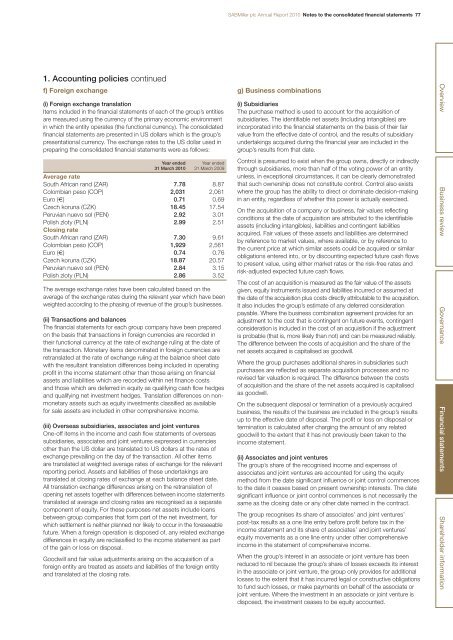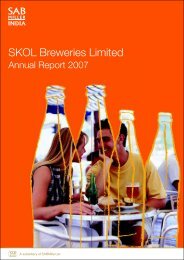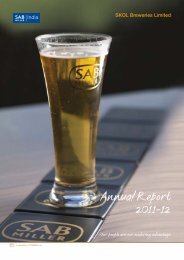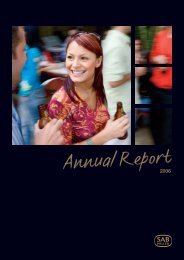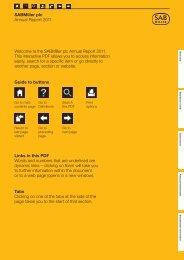Annual Report - SABMiller
Annual Report - SABMiller
Annual Report - SABMiller
- No tags were found...
Create successful ePaper yourself
Turn your PDF publications into a flip-book with our unique Google optimized e-Paper software.
<strong>SABMiller</strong> plc <strong>Annual</strong> <strong>Report</strong> 2010 Notes to the consolidated financial statements 771. Accounting policies continuedf) Foreign exchange(i) Foreign exchange translationItems included in the financial statements of each of the group’s entitiesare measured using the currency of the primary economic environmentin which the entity operates (the functional currency). The consolidatedfinancial statements are presented in US dollars which is the group’spresentational currency. The exchange rates to the US dollar used inpreparing the consolidated financial statements were as follows:Year ended Year ended31 March 2010 31 March 2009Average rateSouth African rand (ZAR) 7.78 8.87Colombian peso (COP) 2,031 2,061Euro (€) 0.71 0.69Czech koruna (CZK) 18.45 17.54Peruvian nuevo sol (PEN) 2.92 3.01Polish zloty (PLN) 2.99 2.51Closing rateSouth African rand (ZAR) 7.30 9.61Colombian peso (COP) 1,929 2,561Euro (€) 0.74 0.76Czech koruna (CZK) 18.87 20.57Peruvian nuevo sol (PEN) 2.84 3.15Polish zloty (PLN) 2.86 3.52The average exchange rates have been calculated based on theaverage of the exchange rates during the relevant year which have beenweighted according to the phasing of revenue of the group’s businesses.(ii) Transactions and balancesThe financial statements for each group company have been preparedon the basis that transactions in foreign currencies are recorded intheir functional currency at the rate of exchange ruling at the date ofthe transaction. Monetary items denominated in foreign currencies areretranslated at the rate of exchange ruling at the balance sheet datewith the resultant translation differences being included in operatingprofit in the income statement other than those arising on financialassets and liabilities which are recorded within net finance costsand those which are deferred in equity as qualifying cash flow hedgesand qualifying net investment hedges. Translation differences on nonmonetaryassets such as equity investments classified as availablefor sale assets are included in other comprehensive income.(iii) Overseas subsidiaries, associates and joint venturesOne-off items in the income and cash flow statements of overseassubsidiaries, associates and joint ventures expressed in currenciesother than the US dollar are translated to US dollars at the rates ofexchange prevailing on the day of the transaction. All other itemsare translated at weighted average rates of exchange for the relevantreporting period. Assets and liabilities of these undertakings aretranslated at closing rates of exchange at each balance sheet date.All translation exchange differences arising on the retranslation ofopening net assets together with differences between income statementstranslated at average and closing rates are recognised as a separatecomponent of equity. For these purposes net assets include loansbetween group companies that form part of the net investment, forwhich settlement is neither planned nor likely to occur in the foreseeablefuture. When a foreign operation is disposed of, any related exchangedifferences in equity are reclassified to the income statement as partof the gain or loss on disposal.Goodwill and fair value adjustments arising on the acquisition of aforeign entity are treated as assets and liabilities of the foreign entityand translated at the closing rate.g) Business combinations(i) SubsidiariesThe purchase method is used to account for the acquisition ofsubsidiaries. The identifiable net assets (including intangibles) areincorporated into the financial statements on the basis of their fairvalue from the effective date of control, and the results of subsidiaryundertakings acquired during the financial year are included in thegroup’s results from that date.Control is presumed to exist when the group owns, directly or indirectlythrough subsidiaries, more than half of the voting power of an entityunless, in exceptional circumstances, it can be clearly demonstratedthat such ownership does not constitute control. Control also existswhere the group has the ability to direct or dominate decision-makingin an entity, regardless of whether this power is actually exercised.On the acquisition of a company or business, fair values reflectingconditions at the date of acquisition are attributed to the identifiableassets (including intangibles), liabilities and contingent liabilitiesacquired. Fair values of these assets and liabilities are determinedby reference to market values, where available, or by reference tothe current price at which similar assets could be acquired or similarobligations entered into, or by discounting expected future cash flowsto present value, using either market rates or the risk-free rates andrisk-adjusted expected future cash flows.The cost of an acquisition is measured as the fair value of the assetsgiven, equity instruments issued and liabilities incurred or assumed atthe date of the acquisition plus costs directly attributable to the acquisition.It also includes the group’s estimate of any deferred considerationpayable. Where the business combination agreement provides for anadjustment to the cost that is contingent on future events, contingentconsideration is included in the cost of an acquisition if the adjustmentis probable (that is, more likely than not) and can be measured reliably.The difference between the costs of acquisition and the share of thenet assets acquired is capitalised as goodwill.Where the group purchases additional shares in subsidiaries suchpurchases are reflected as separate acquisition processes and norevised fair valuation is required. The difference between the costsof acquisition and the share of the net assets acquired is capitalisedas goodwill.On the subsequent disposal or termination of a previously acquiredbusiness, the results of the business are included in the group’s resultsup to the effective date of disposal. The profit or loss on disposal ortermination is calculated after charging the amount of any relatedgoodwill to the extent that it has not previously been taken to theincome statement.(ii) Associates and joint venturesThe group’s share of the recognised income and expenses ofassociates and joint ventures are accounted for using the equitymethod from the date significant influence or joint control commencesto the date it ceases based on present ownership interests. The datesignificant influence or joint control commences is not necessarily thesame as the closing date or any other date named in the contract.The group recognises its share of associates’ and joint ventures’post-tax results as a one line entry before profit before tax in theincome statement and its share of associates’ and joint ventures’equity movements as a one line entry under other comprehensiveincome in the statement of comprehensive income.When the group’s interest in an associate or joint venture has beenreduced to nil because the group’s share of losses exceeds its interestin the associate or joint venture, the group only provides for additionallosses to the extent that it has incurred legal or constructive obligationsto fund such losses, or make payments on behalf of the associate orjoint venture. Where the investment in an associate or joint venture isdisposed, the investment ceases to be equity accounted.Overview Business review Governance Financial statements Shareholder information


